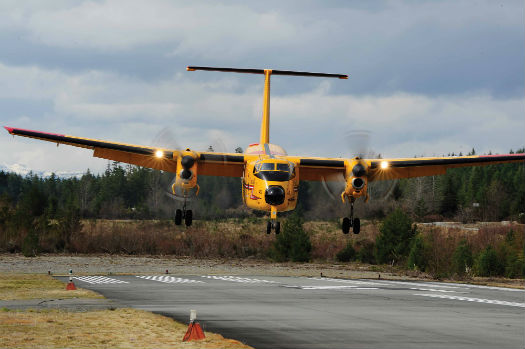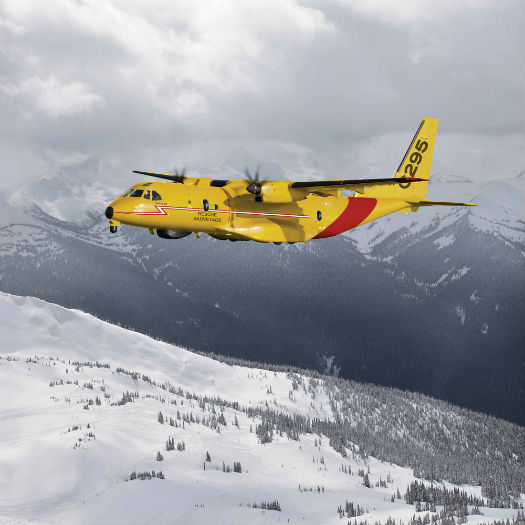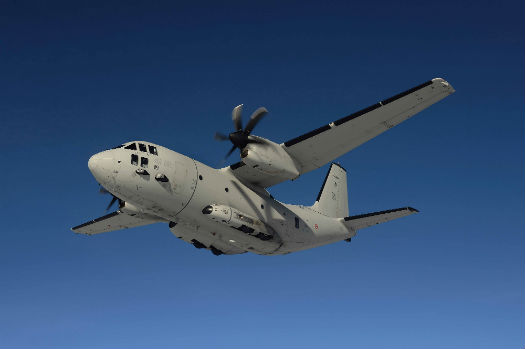The Lockheed Martin CC-130H Hercules gives RCAF search and rescue crews the long legs they need for missions in the Arctic and offshore. The first H model entered service in 1996 and is considered a highly-capable platform, but there have been suggestions that it is ill-suited to low-level searches in mountainous terrain, where a smaller aircraft capable of flying lower and slower is a preferred platform. Mike Reyno Photo
The nail-biting begins in earnest on both sides of the Atlantic at 14:00 EDT on Monday, Sept. 28. That’s when the clock stops in Ottawa and the Canadian government’s request for proposals to supply Canada’s next fixed-wing search and rescue (FWSAR) aircraft will be officially closed. How long it will take for the government to evaluate the submissions and make a decision is anyone’s guess, but it is expected to take at least six months—which means the decision should come down long after Canada’s next general election on Oct. 19.
The first of about 18 new aircraft—which will replace six pensionable de Havilland CC-115 Buffalos and 11 Lockheed Martin CC-130H Hercules (a 12th was decommissioned after a February 2012 fire)—is expected to enter service “by about 2018-ish,” according to BGen Phil Garbutt, director general of force development for the Royal Canadian Air Force (RCAF).
Meanwhile, several industry project teams have been plowing their way through the formal request for proposal (RFP) issued by Public Works and Government Services Canada (PWGSC) at the end of March. “The intent . . . is to procure a fleet of new sensor-equipped aircraft, including long-term In-service Support (ISS) for a period up to 20 years,” the department said in a covering note for the RFP, which tips the scales at more than 2,000 pages—and which will likely draw equally voluminous responses.
Originally, there were two front-runners for the contract, both high-wing twin-engine turboprops similar to the Buffalo in basic configuration: the Alenia C-27J Spartan, built in Italy by a division of Finmeccanica Group; and the CASA C-295, manufactured in Spain by Construcciones Aeronáuticas Sociedad Anónima (CASA), which is now part of Airbus Defence & Space (ADS).
DND wasn’t able to hide its original leanings toward the C-27J, even though it was larger, faster and had longer legs, and likely would be more expensive than the C-295. That led to accusations by Airbus in 2005 that DND had written its specifications to effectively limit the choice to the C-27J.
The CC-115 Buffalo is becoming more expensive to maintain. Its looming retirement is the critical factor driving Canada’s procurement of a new fixed-wing SAR aircraft. Mike Reyno Photo
The ongoing delays in the procurement—including an unprecedented government-ordered National Research Council review in 2010, which prompted changes to the Statement of Operational Requirements—have meant that other aircraft options are now on the table. They include an expansion of the RCAF fleet of Lockheed-Martin CC-130Js as well as a couple of probable long-shots: the Bell Boeing V-22 Osprey tilt-rotor and the Embraer KC-390 military transport. All five contenders feature a rear ramp, which is a core RCAF requirement for SAR work.
While sources say some Canadian companies are interested in partnering with Embraer, the KC-390 is still in development, having completed its first flight this past February. The Brazilian manufacturer did not respond to Skies’ request for comment on the RFP, but the production version of the only jet in the mix is not expected to be ready until sometime next year. Unit costs are unknown, but the company is counting on “the lowest life-cycle cost in the market” to give it an edge in its category.
Bell Boeing likes to point out that the V-22 is the only option which offers “search” and “rescue” capabilities in one platform, blending the speed and range of a fixed-wing platform with the maneuverability and vertical takeoff and landing attributes of a helicopter. It has been used to good effect by the U.S. Marine Corps in Afghanistan, after some early misgivings which resulted from a couple of high-profile accidents.
The V-22 Osprey’s versatility remains a key element of Bell Boeing’s official position as it reviews the RFP “before making a decision whether or not to compete,” Becky Yeamans, a Washington-based spokesperson for Boeing Defense, Space and Security told Skies shortly after the RFP was published. “The V-22’s combination of speed, range, payload and vertical lift are ideally suited to the search and rescue requirements of several international militaries, and we feel the tilt-rotor would bring an expanded set of capabilities and performance to the Canadian FWSAR mission.”
The C-295, built in Spain by a division of Airbus Defence & Space, can fly low and slow, suiting it well for search and rescue missions in confined mountainous terrain. Airbus Photo
As for Lockheed Martin, using C-130J Hercules aircraft for SAR missions could offer economies of scale to the RCAF, because the aircraft is already part of its current fleet. The spares inventory would be more manageable; however, a possible drawback is the fact that the Herc has four engines. That’s an element the manufacturer downplayed in late 2013, after the draft RFP was released.
Ed Arner, Lockheed Martin’s FWSAR “campaign lead,” told Skies at the time that having twice as many engines as the competition would actually be a plus. “You don’t want to be halfway to Shannon, Ireland . . . 300 feet off the deck looking for a boat or a person in the water, and suck in a bird . . . in a two-engine aircraft,” he said. “You really want the safety and security that comes with being able to have four engines.”
Today, Lockheed Martin’s involvement in the FWSAR competition remains speculative despite its track record with the RCAF fleet of legacy Hercules, which has been supported by Cascade Aerospace Inc., a division of IMP Group Ltd. Now that the final RFP is out, Arner reiterated in a brief email that the company is “assessing” it to determine “how we . . . can provide a best value solution.” Based on his earlier comments, however, Arner believes the C-130J is a “natural participant” in Canada’s SAR role.
Like the Hercules and Buffalo, the new FWSAR aircraft will work alongside Canada’s fleet of AgustaWestland CH-149 Cormorant SAR helicopters. Mike Reyno Photo
Over at Team Spartan, “strategic advice” comes from Steve Lucas, Canada’s chief of the air staff from 2005 to 2007, and Richard Mohns, who managed DND’s procurement of AgustaWestland CH-149 Cormorant SAR helicopters in the late 1990s.
Asked whether the formal RFP differed significantly from the 2013 draft, Lucas told Skies that the original draft covered “about 75 to 80 per cent of what the government wanted to show” and that the rest trickled in from PWGSC over the last 18 months or so. “Some small items have emerged in the final RFP—small in terms of numbers, but significant in terms of their impact,” he added, without going into detail. “We’re in the process of examining these right now.”
The most significant development was how “points” for aircraft capability, cost, and the fundamental “best value determination” of the program were to be assigned. The latter was always 10 per cent, and while there was early uncertainty about the capability/cost split; Lucas said Team Spartan is “quite pleased” that it has been set at 65/25 per cent.
“The capability/cost split is quite attractive to us, and reflective of the importance of performance and capability. That being said, there’s a lot of analysis that still has to be done and we’re very early on in the process, so I can only give you my initial impressions. We have a long way to go. We have six months, and we’ll use every minute of that to ensure that we craft the best possible bid we can,” he added.
It remains to be seen whether Lockheed Martin will put forward its C-130J Hercules as Canada’s next fixed-wing SAR platform. Mike Reyno Photo
Team Spartan includes Alenia Aermacchi as the aircraft builder; General Dynamics Canada (GDC) as the mission system source and ISS integrator; DRS Technologies for training systems; and Kelowna Flightcraft as the MRO provider. IMP will modify the green aircraft for the FWSAR role here in Canada, and CMC Electronics from Montreal will provide the flight management system. With several other Canadian suppliers lined up to provide key components, Canadian industry from coast to coast will be heavily engaged.
“The C-27J is extremely robust and brings together many of the capabilities that the SAR crews are looking for,” said Lucas. “It’s faster than other aircraft in its class and has exceptional handling, especially at search speeds. It also has great cockpit visibility, more than ample cabin size and outstanding manoeuvrability and STOL [short takeoff and landing] capabilities. The C-27J Spartan is the most capable FWSAR aircraft available and represents the best value to Canada. Team Spartan will deliver the complete package, which makes us confident that we will be able to easily meet Canada’s requirements and do it from the existing main operating bases.”
Lucas added that other than the evolution of satellite technology, SAR operations have not changed much since the Second World War. “It’s time to make a change for the better by taking advantage of new technologies; it’s time to provide the RCAF with a new SAR platform and systems that will operate effectively for the next 30 to 50 years,” he said.
Pablo Molina, head of ADS Military Aircraft Canada, suggested that his team might not need the full six months to prepare its bid—but he didn’t say they would submit early, either.
“How we have reached this point . . . is very complex,” he said in a Skies interview. “In our case, being the most proven and low-risk platform and the market leader, we have been able to respond in less time. [However,] the longer we take, the better the responses the government will have.”
The Alenia C-27J Spartan, built in Italy by a division of Finmeccanica Group, was long rumoured to be the RCAF’s preferred platform to replace its aging fixed-wing search and rescue fleet. Katsuhiko Tokunaga Photo
While many observers have suggested that Alenia is Airbus’ only other viable contender, Molina said the government has done “a good thing” by letting other OEMs compete for the program. “For us, it’s not an issue whether we compete with one aircraft or two, because our partners are the ones that we think can bring more value to Canada.”
Provincial Aerospace, based in St. John’s, N.L., would provide in-service support for the C-295; CAE Inc. of Montreal would deliver the training regimen; and L-3 Wescam of Burlington, Ont., would provide the chin-mounted sensor turret. Pratt and Whitney Canada of Montreal would supply the same PW127G engines it has delivered for all of Airbus’ C-295 production, while Vector Aerospace of Summerside, P.E.I., would handle engine maintenance.
Calling Airbus the “market leader right now in this kind of segment,” Molina said that “if the budget has remained the same, a cost-effective solution such as the one that we are proposing is going to be well-received by the government.”
As for the actual number of aircraft which would be in the Airbus package, Molina demurred, saying it depends on the scoring between capability, cost and the value proposition. “All of our team members are calculating all the different possibilities, so it’s too early address that question without compromising the answer.”
Bell Boeing’s V-22 Osprey tilt-rotor aircraft is likely a long-shot contender for Canada’s FWSAR program. Ted Carlson Photo
Critical Need
For the time being, although the Buffalos and legacy H-model Hercules continue to provide yeoman service in some of the most rugged terrain and challenging weather conditions on the planet, their replacements can’t come soon enough. The need to replace the Buffalos was acknowledged in the 1980s, with the premise being that a 30-year service life meant that new aircraft should preferably enter service before the end of the century.
Decades later, the long-awaited release of the official RFP represents a significant step toward the acquisition of capable new aircraft for Canada’s search and rescue professionals. Garbutt acknowledged the delays, but said the RCAF remains “bullish” about FWSAR.
He noted that although the notion of a mixed fleet of two aircraft types has been floating around for some time, a single type is preferred. “By about 2018-ish, we’ll see the first of the fixed-wing SAR aircraft come through and ultimately replace the Buffalo and then eventually the H-model Hercs,” said Garbutt, a former Buffalo and Boeing Vertol CH-113 Labrador helicopter pilot.
“We see the aging Buffalo as kind of being the critical aircraft in all of this,” he concluded. “Worldwide, we’ve tapped into about all the sources of supply we could find for that, so the sooner we can replace that aircraft, I think it’s in the best interests of our SAR operation. . . . Depending on how much money you want to spend, you can sustain aircraft forever, but the value for your dollar becomes questionable.”













